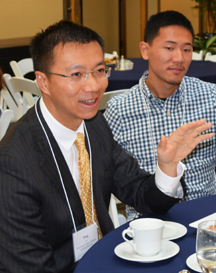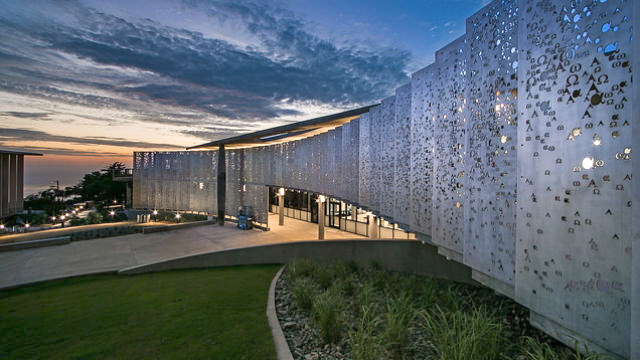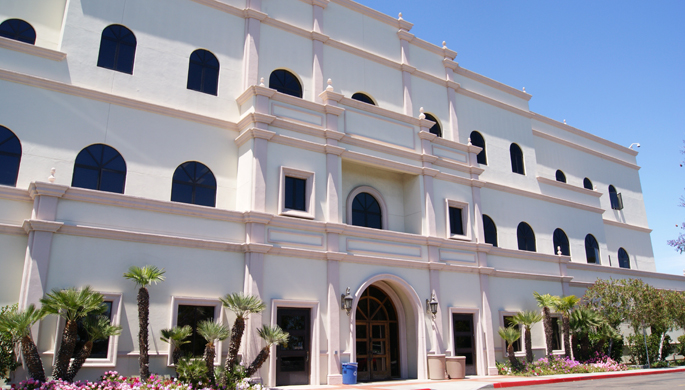Daily Business Report-Nov. 23, 2015
The USS Theodore Roosevelt at sea.
USS Theodore Roosevelt
Arriving in San Diego Today
The next aircraft carrier to call San Diego its home port — the USS Theodore Roosevelt — is scheduled to arrive this morning.
The 1,092-foot-long “Big Stick” is completing what amounts to an epic voyage, in which it left its old base in Norfolk, Va., more than eight months ago for deployment to the Middle East.
Air squadrons aboard the Roosevelt flew more than 1,800 combat sorties against Islamic State targets in Iraq and Syria, racking up 10,600 flight hours for the crews.
Most of the action took place during the summer, when temperatures rose well over 100 degrees. The 29-year-old Roosevelt, named for the 26th president, is part of a three-way swap of carrier home ports.
The USS George Washington, formerly based in Japan, was sent to Virginia to have its nuclear power plant refueled. The USS Ronald Reagan, based in San Diego for 11 years, replaced the George Washington in Japan.
About two-thirds of the 3,300 or so Roosevelt sailors will fly on from San Diego to Virginia, where they will take over the George Washington. Most of the Reagan’s crew sailed the GW around the tip of South America and up to the U.S East Coast.
They’ll fly back to San Diego and become the Big Stick’s crew. Around one-third of each vessel’s sailors, mainly command staff and nuclear power experts, stayed with their ships. The complicated process is estimated to be saving the Navy $41 million in personnel transfer costs.
____________________________________________

Regional Airport Authority Picks
$2.2 Billion Plan to Replace Terminal 1
Times of San Diego
The San Diego County Regional Airport Authority Board announced Friday that it has chosen a $2.2 billion plan for replacing Terminal 1 that is the quickest, least costly and leaves the most space for future parking.
The plan, the fifth option considered by the authority, calls for two long wings of gates at either side of a new international facility with centralized customs processing. The new terminal would replace the easternmost gates of Terminal 2.
The plan now heads to environmental review, which is expected to take until the middle of 2017, before construction can start.
The work will include a new roadway separate from Harbor Drive to handle airport traffic exclusively, a bridge from the closest trolley station, additional overnight aircraft parking and demolition of both Terminal 1 and the Commuter Terminal.
The project will add at least 10 new gates and increase the airport’s capacity to 28 million passengers per year from the current 19 million.
The new project follows the Green Build, completed in 2013, which added 10 new gates and additional aircraft parking at Terminal 2. A new rental car facility is currently nearing completion on north side of the airport.
No tax dollars are involved in the project because San Diego International Airport is funded through its own revenue.
Noted Biochemist Joins
Scripps Research Institute

Peng Wu, formerly of Albert Einstein College of Medicine in New York, is joining The Scripps Research Institute as an associate professor in the Department of Chemical Physiology.
For Wu, who received his doctorate from TSRI in 2005 under the guidance of Nobel Laureate K. Barry Sharpless, the appointment is somewhat of a homecoming — but with a vision focused firmly on the future.
“I am thrilled to come back to Scripps,” said Wu. “The institute has a world-leading program in chemical biology, especially in the field of chemical glycobiology and activity-based protein profiling, which provides me with wonderful opportunities to collaborate with leading experts — Professors Paulson, Wong, Kelly, Cravatt, Yates and many others.”
In 2008, he joined Albert Einstein College of Medicine, where he rose through the ranks to become an associate professor of biochemistry and the scientific director of the Chemical Biology Core Facility.

San Diego Apartment Rents Up
Only 5.4 percent Over Past Year
Times of San Diego
Apartment rental rates in San Diego are up nearly 5.4 percent over the past year, but that increase is not much higher than the national average, according to the online real estate company Zillow.
San Diego ranked only tenth among major metro areas, with Denver, Portland, San Franciso and San Jose all reporting double-digit increases. San Francisco’s rental rates were up a whopping 15.2 percent.
The national average was 4.5 percent.
Zillow said newly built apartment buildings are finally opening and slowing the rate of rental appreciation across the country, but rents are still rising much faster than the historical norm and continue to rise faster than incomes.
Multifamily housing starts have been increasing since late 2009, and as units become available, the pace of rental appreciation is slowing. Lack of inventory has been a leading cause of the ongoing rental affordability crisis, especially in fast-growing markets.
“Rental appreciation has started to slow down in part due to more rental supply. Many of the bigger multifamily rental projects that were begun a couple years ago in cities nationwide are finally starting to open for occupancy, easing pressure on rents somewhat,” said Zillow Chief Economist Dr. Svenja Gudell.

Point Loma Nazarene Dedicates
Innovative New Science Complex
Times of San Diego
Point Loma Nazarene University on Friday dedicated a state-of-the art science complex that is also an innovative architectural statement with a cathedral-like ambiance.
The innovative design, marked by a curved stainless-steel environmental screen and a prominent site overlooking the Pacific Ocean, will be home to the university’s rapidly growing and acclaimed interdisciplinary science program. The program seeks to unify Christian values with a broad curriculum and state-of-the-art technology, laboratories and classrooms.
“Through the long arc of a perforated stainless-steel wall, the building subtly consecrates its Christian foundations in a salient design feature,” said architect Ray Varela, who led the project for San Diego-based Carrier Johnson + CULTURE “This unique screen filters sun and shade into the common area in a subtle echo of the qualities one finds in a cathedral space.”
Nearly 40 percent of the university’s students major in a science-related discipline, and all are required to complete a laboratory science course during their education.
“Every student at PLNU will benefit from this investment” said Dr. Sara Choung, chair of the chemistry department. “This much-needed facility better reflects the quality of the faculty, students and alumni who have stretched PLNU’s science program in remarkable directions.”
University President Bob Brower said the 36,000-square-foot facility “will enable the science program to reach new heights and support the continued success of our PLNU science faculty and students.”
Point Loma Nazarene is a selective Christian liberal arts institution that serves more than 3,500 students.
SANDAG Faces $50,000 Fine
In Mission Bay Pollution Case
City News Service
State water officials proposed a $50,000 fine on Friday against the San Diego Association of Governments for allowing sediment from a construction project in Rose Creek to flow into Mission Bay.
The San Diego Regional Water Quality Control Board complaint alleges that SANDAG failed to implement routine management practices to prevent the runoff in September.
“It’s surprising that an organization with so much experience in linear construction projects would let this happen,” said Chiara Clemente, the water board’s enforcement coordinator. “The proposed penalty would have been much greater, had they not been responsive in implementing the necessary management measures.”
The runoff was reported to the water board by a citizen, and SANDAG’s contractor fixed the problem. The contractor was realigning railroad tracks near Regents Road, Jim Linthicum, SANDAG’s director of mobility told City News Service.
“This is the first instance this has happened,” Linthicum said about the fine. “We’re trying to figure out the process and procedures.”
He said the project involved grading work, and a rainstorm overwhelmed erosion barriers.
Water board officials said excess sediment can alter or obstruct flows, resulting in flooding, and it can damage local ecosystems.
Abnormally high levels of sediment in the water can smother aquatic animals and habitats, and it can reduce the clarity of water, which harms the ability of organisms to breath, find food and refuge, and reproduce, according to the water board.
Sediment can also act as a binder, carrying toxic constituents such as metals, pesticides and other synthetic organic chemicals into rivers, bays and the ocean.
The San Diego water board scheduled a Feb. 10 hearing to consider the complaint.SANDAG can pay the penalty, propose a settlement or supplemental environmental project, or contest the allegations.
Biocept Secures Agreements
With Preferred Provider Networks
San Diego-based Biocept Inc., a molecular diagnostics company developing biomarkers used in liquid biopsies to improve the detection and treatment of patients with cancer, announces two new agreements with preferred provider organization (PPO) networks.
Fortified Provider Network and Three Rivers Provider Network members now have network access to Biocept’s proprietary non-invasive liquid biopsy testing. These new agreements cover 26 million members, bringing the total number of consumers with access to Biocept’s blood-based liquid biopsy testing through their health care plans to approximately 133 million, according to the company.




